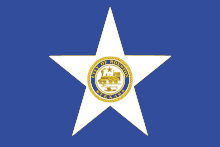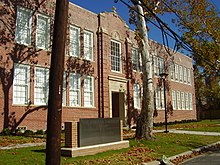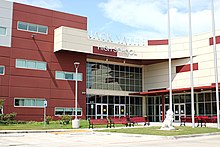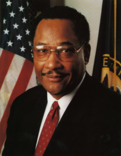A | B | C | D | E | F | G | H | CH | I | J | K | L | M | N | O | P | Q | R | S | T | U | V | W | X | Y | Z | 0 | 1 | 2 | 3 | 4 | 5 | 6 | 7 | 8 | 9
This article has multiple issues. Please help improve it or discuss these issues on the talk page. (Learn how and when to remove these template messages)
|
| Total population | |
|---|---|
| 528,145 (2019) | |
| Regions with significant populations | |
| Throughout Houston and its suburbs | |
| Languages | |
| Southern American English, Texan English, African American English, African American Vernacular English | |
| Religion | |
| Black Protestant, Roman Catholic |


| Part of a series on |
| Ethnicity in Houston |
|---|
|
|
|
| Part of a series on |
| African Americans |
|---|

The African American population in Houston, Texas, has been a significant part of the city's community since its establishment.[1] The Greater Houston area has the largest population of African Americans in Texas and west of the Mississippi River. Black Enterprise has referred to Houston as a Black mecca.[2]
History

When Houston was founded in 1836, an African-American community had already begun to be established.[1] In 1860, 99% of the city's African American population was enslaved;[3] there were eight free blacks and 1,060 slaves.[1] Before the American Civil War, enslaved African-Americans living near Houston worked on sugar and cotton plantations, while most of those living within the city limits held domestic and artisan jobs.
Although slavery ended after the U.S. Civil War, by the mid-1870s racial segregation became codified throughout the South, including Texas.[4] African Americans in Houston were poorly represented by the predominantly white state legislature and city council, and were politically disenfranchised during the Jim Crow era; whites had used a variety of tactics, including militias and legislation, to re-establish political and social supremacy throughout the South.[5]
In 1929 Houston Planning Commission chairperson Will Hogg made a proposal to designate areas of the city by race in its zoning so African-Americans do not become too numerous near White communities; the city did not enact this as it never adopted zoning.[6]
In the 1940s and 1950s black people from small southern towns moved to Houston, resulting in the black communities increasing in size. The black population in the Third Ward became larger and therefore closer in proximity to nearby Jewish communities.[7] White people began to move from the Third Ward area, partly due to the passage of Brown vs. Board of Education in 1954.[8]
Texas Southern University students led the integration of Houston in the 1960s. On Friday, March 4, 1960, Texas Southern University students led Houston's first sit-in at the Weingarten's grocery store lunch counter located at 4110 Almeda Road.[9] That sit-in played a major role in the desegregation of Houston's white owned businesses. Today, a U.S. Post Office sits at that location; however, a Texas Historical Marker sits in the front of the building reminding visitors of the courageous role TSU students played in the desegregation of Houston, Texas.[10] Six months after their first sit-in, 70 Houston lunch counters were desegregated. The success of their continued efforts eventually led to the full integration of businesses within the city.[11]
In 1970, 90% of the black people in Houston lived in mostly African-American neighborhoods. By 1980 this decreased to 82%.[12]
Historically, the City of Houston placed established landfill facilities in established African American neighborhoods. Private companies also located landfills in black neighborhoods. Between the early 1920s and the late 1970s the five municipal sanitary landfills were in black neighborhoods. During the same period, six of the eight municipal solid waste incinerators resided in mostly black neighborhoods. From 1970 to 1978 three of the four private landfills established during that period were located in Houston black neighborhoods.[12] Around that era African Americans made up around 25% of the city's population. Houston City Council, which decided where the landfills would be located, was entirely composed of white residents until 1972.[13] The political efforts and advocacy behind a 1979 federal lawsuit regarding one proposed landfill led to political changes that ended the deliberate placement of landfills in black neighborhoods.[13][14]

In 1980, the city had 440,257 African American residents, making it one of the largest black populations in the country.[1] As of 1987 most African Americans in Houston continued to live in inner-city black neighborhoods, even though they gained the legal right to move to any neighborhood. According to research at the University of Chicago, many African Americans choose to live in neighborhoods where they were raised.[15]
From the 1980 U.S. Census to the 1990 U.S. Census, many African Americans left traditional African-American neighborhoods such as the MacGregor area, Settegast, Sunnyside, and the Third Ward and entered parts of Southwest Houston, such as Alief, Fondren Southwest, Sharpstown, Westchase, and Westwood.[16] Meanwhile, a significant percentage of Houston's Non-Hispanic whites population (particularly those with children under 18) left the city for suburban communities, this phenomenon was known as white flight.[17]
In 2004, some African-Americans who had lived in the suburbs had returned to the inner city area due to their previous ties to those communities.[18]
By 2005 the outflow from traditional black neighborhoods, such as the Third Ward, Sunnyside, Kashmere Gardens, and the Fifth Ward continued, with blacks moving to Alief, other parts of Southwest Houston, Fresno, Missouri City, and northwestern suburbs. Around 2005, African Americans began to move to an area around Farm to Market Road 1960, in an unincorporated area in Harris County. In many traditional inner-city black neighborhoods, Mexican and Latino residents moved in.[19] In addition to the New Great Migration, many African Americans in the US are now recently moving to Houston for lower cost of living and more job opportunities.[20] Houston gained approximately 233,000 African-Americans between 2000 and 2010.[21] Having the largest black population west of the Mississippi River, Houston is known as a center of African-American political power, education, economic prosperity, and culture, often referred to as a black mecca.[2] Houston is ranked among best U.S. metros for Black professionals.[22]
According to LendingTree, there are 3,586 Black-owned businesses out of 108,772 total businesses in Houston. Thats 3.3% while Black Americans make up 22.4% of Houston's population.[23]
An additional 150,000 to 250,000 mostly black evacuees arrived in 2005 from the New Orleans metro after Hurricane Katrina, with many of them deciding to stay in Houston.[24]
Commerce
The African American community in Houston had a rich diverse economic history. Throughout the communities, many businesses flourished. The Wards, 3rd, 4th and 5th had many restaurants, theaters, clubs, boarding houses, carriage delivery services, millinery shops (hat shops), stationery shops, newspaper publishers, dry goods stores, banks-savings and loans, insurance companies, seamstresses and tailor shops just to name a few. There were two major office buildings that housed many African American businesses, the Pilgrims Building [25][26] The agricultural history included a host of farmers and ranchers.[27][28] was home to Sky Ranch the African American airport/air transport service, started by Tuskegee Airmen in the mid-1900s. In the early 1900s the community celebrated DeRoLoc which helped to promote the economic development of the community. This week long event was celebrated by an Agricultural/Industrial Exhibition, Ball, and Carnival. Many of the businesses benefited by all the people that attended from the region. The first Official DeRoLoc Event in Emancipation Park (Oldest park in Texas-donated by Freed Slaves) hosted 4,000 people (Fall 1901-some people say it was 1909), the event stopped in 1929 and was recently revived by a local business (NuWaters Co-op) in Houston. In Acres homes, there was the first African American Bus Company that made many runs to/from downtown Houston, to Acres homes providing transportation to many African Americans.[29]
Cuisine
The Louisiana Creole people who settled Houston around the 1920s brought their cuisine with them. The Creole and Cajun cuisine style spread in Houston in the post-World War II era,[30] which led to various Creole food chains such as Frenchy's Chicken, Pappadeaux, and Popeyes.[31] Creole dishes include boudin, black rice and shrimp creole, crawfish, gumbo, and jambalaya.[30] Bernadette Pruitt, author of The Other Great Migration: The Movement of Rural African Americans to Houston, 1900-1941, wrote that Creole cooking became "an important cultural bridge" in the city and in its African American community, and that, "As cooks, Creole housewives transformed Houston's typical southern cuisine."[30]
In 2021 Alison Cook of the Houston Chronicle wrote that hamburger restaurants in historically black neighborhoods in Houston typically prepare hamburgers "exceptionally charred and well-done".[32]
In 2020, according to Emma Balter of the Houston Chronicle most of the vegan restaurants she chronicled, in a list that was "comprehensive, yet not exhaustive", were owned by African-Americans.[33]
Demographics
From the 1870s to the 1890s, African Americans made up almost 40% of Houston's population. Between 1910 and 1970 the African American population ranged from 21% to 32.7%.[3]
In 1870 36% of the African-Americans in Houston lived in the Fourth Ward, 29% lived in the Third Ward, 16% lived in the Fifth Ward, and 19% lived in other areas. In 1910 the plurality now lived in the Third Ward, with 32%; the Fourth Ward, Fifth Ward, and other areas had 27%, 21%, and 20% respectively.[34]
There were about 34,000 African-Americans in Houston in the 1920s, and in the 1930s there were about 63,000 African-Americans.[35] In 1920, 20% of the people classified as "black" were subclassified as "mulatto"; the census stopped taking statistics on "mulatto" people after 1920. In the racial segregation era people of Louisiana Creole origin with African heritage attended black institutions such as schools even though they often considered themselves racially distinct from non-Creole African Americans.[36] Creoles spoke Louisiana Creole French, making them linguistically distinct. Creoles also had different musical practices as they performed Southwest Louisiana-style "la-la".[36] In the 1920s the "San Felipe districts" had the largest group of African-Americans, the Third and Fifth wards had other significant communities.[37]
In 1940 the African-American population numbered 86,302, 21.4% of the number of people in Houston. The same population increased to 125,400, 21% of the city population, in 1950. 87.9% of the population increase from 1940 to 1950 was due to African-Americans moving from other parts of the United States, mostly Louisiana and Texas; most of the migrating African-Americans from rural areas and small towns. 1960 the African-American population numbered 215,037, 25.7% of the city population. In the central city, from 1950 to 1960, the African-American population increased by 20,299. Their percentage of the total population increased during that period from 23.4% to 31.1% because large numbers of white people left the central city. In 1970 the African-American population numbered 316,922, 25.7% of the city population.[7] By 1980,[12] Houston had 440,257 African American residents, making it one of the largest black populations in the country.[1]
In 2004 55% of the African American population born in Harris County originated from the Houston area either by birth or through growing up there as children.[18]
Between 2010 and 2015, Houston added about 100,000 new black residents to the area. Only behind the Atlanta and Dallas areas.[38]
Many African Americans in the US are now recently moving to Houston due to the city's well-established and influential Black or African American community.[39]
The Houston area has the largest African-American community in Texas and one of the top 10 in the nation.
Cultural institutions
The Houston Museum of African American Culture (HMAAC) and Buffalo Soldiers National Museum located in the Houston Museum District.[40]
The Community Artists' Collective located in the midtown area is a hub for black creatives and art.[41]
The University Museum located on the campus of Texas Southern University is an art gallery that primarily highlights art by and about people in the African diaspora.[42]
The Rutherford B. H. Yates Museum preserves the legacy of African Americans in Houston's Freedmen's Town.[43]
Shrine of the Black Madonna is a cultural center, museum and bookstore that is owned and operated by the Pan-African Orthodox Christian Church.[44]
Ovide Duncantell (died 2018) founded the Houston Black Heritage Society.[45]
The Houston Black Chamber of Commerce serves and supports black businesses and professionals.[46]
Politics
Lee P. Brown, elected in 1997, was the first black Mayor of Houston.[47] He was the city's 50th mayor.[48]
As of 1997, African Americans typically constituted less than 25% of the electorate of the City of Houston. For the election of Lee P. Brown, blacks may have made up over 33% of the turnout. Brown won 90% or more in African-American neighborhoods.[49]
As of 2005 Sheila Jackson Lee, a Houstonian, is one of two black Texan U.S. House of Representatives members.[50] Al Green (Texas 9th district), also from Houston, is the other.
On December 13, 2015, Houston elected its second African-American mayor, Sylvester Turner.[51]
Religion


The number of African American Catholics in Houston increased after the Great Mississippi Flood of 1927 affected rural areas in the Southern United States.[52] Most of them moved to the Fifth Ward.[53] Due to a perception of the Catholic church being more favorable to African Americans than Protestant churches, the Catholic church in Houston increased in popularity with African Americans in the 1930s.[54]
The oldest black church in Houston is Trinity United Methodist Church, which was started by Rev. Elias Dibble who came from Mississippi to establish churches.[55]
The oldest Black Baptist church in Houston is the Antioch Missionary Baptist Church, historically a part of the Freedmen's Town of Fourth Ward and now in Downtown Houston.[56] Jack Yates once served as the pastor of this church.[57]
The city's first black Catholic church was St. Nicholas, located in the Third Ward.[58] The Our Mother of Mercy Catholic Church in the Fifth Ward, Houston's second black Catholic church, was officially founded in June 1929.[59] Houston area black Catholic churches have elements of Louisiana Creole culture such as zydeco parties.[60]
In the 1920s, prior to the construction of Our Mother of Mercy, a group of Louisiana Creole people attended the Hispanic Our Lady of Guadalupe Church because it was the closest church to the Frenchtown area of the Fifth Ward.[58] Because the Our Lady of Guadalupe Church treated the Creole people in a discriminatory manner, by forcing them to confess and take communion after people of other races, and requiring them to take the back pews,[61] the Creoles opted to build their own church.[62]
The number of African-American Catholics in Houston increased after the Great Mississippi Flood of 1927 affected rural areas in the Southern United States.[52] Most of them moved to the Fifth Ward.[53] Due to a perception of the Catholic church being more favorable to African-Americans than Protestant churches, the Catholic church in Houston increased in popularity with African-Americans in the 1930s.[54] St. Anne de Beaupre in Sunset Heights,[63][64] near the Houston Heights, is the third black church. Named after the Basilica of Sainte-Anne-de-Beaupré in Sainte-Anne-de-Beaupré, Quebec, Canada, opened in 1938. The naming after a Francophone Canadian site reflects the Louisiana Creole culture.[65]
Media
The Houston Forward Times, which began publication in 1960,[66] is the largest black-owned newspaper in the city.[67] The Houston Defender and the African-American News and Issues are other well established black-owned papers. The Texas Freeman was founded in 1893 and later merged to become The Houston Informer and Texas Freeman.[54]
KCOH 1430 AM was a black-owned radio stationed started in 1953.[68] It was a focal point for the Houston black community located at the iconic "looking-glass" studios on 5011 Almeda in Midtown Houston. KCOR launched the careers of radio personalities Michael Harris, Ralph Cooper, Don Samuel, Wash Allen. The station was purchased in 1976 by a consortium of investors, led by its general manager at the time, Michael Petrizzo.[69] After his death in January 2012, the radio station was put up for sale. The 1430 AM signal was eventually sold to Catholic-oriented, La Promessa Foundation's Guadalupe Radio Network in November 2012.[70] The Petrizzo family continued to own the historic building and equipment, leasing them and the 1230 AM signal to Dunn Ministries which continued the Urban Oldies format. KCOH announced in January 2016 that it has plans to move to the FM dial.[71]
The Houston Sun was established by Dorris Ellis and Lonal Robinson in 1983. It has won more than 200 awards and recognition[who?] and presents the First Amendment Conference annually for high school and college journalism students during March, African American Press Month. Dorris Ellis was awarded the Gutenberg Press Award by the Printing Museum of Houston in 2015. The Sun's staff is made up of journalists and interns who covers city hall, school board and local community news.[citation needed]
Education

Texas Southern University is one the largest historically Black colleges (HBCUs) in the U.S. and the only HBCU fully based in Houston. Prairie View A&M University based in Prairie View, Texas (immediately northwest of Houston) is also one of the largest HBCUs in the U.S. and the second oldest public university in the state.[72]
Historically black high schools (schools reserved for black students prior to desegregation in the 1960s) in Houston include:
Historically black middle schools include:
- Ryan Middle School (closed 2013)
The Imani School is marketed towards African-American families.[73]
Opinions varied on whether the North Forest Independent School District (NFISD), which closed in 2013,[74] was a "historically black" district, and therefore also the largest historically black district in the state to be closed; Kimberly Reeves of the Houston Press noted that the district had not been predominately African-American in the segregation era and remained so since desegregation, into the 1970s.[75]
History of primary and secondary education

After the U.S. Civil War Freedmen's schools served black children. Later a private school in the Fourth Ward, the Gregory Institute, opened and began serving the children.[76]
In 1892 Colored High School, the first high school for black students, opened.[35] There were 8,293 students in Houston's schools for black students in the 1924–1925 school year.[77] In 1925 the Houston school board announced that a new high school would open in the Third Ward, in light of the large increase in the black population. The Houston Informer stated that the schools needed to be named after prominent black people from the city and/or other successful black persons.[35]
With the construction of the former Jack Yates High School (later Ryan Middle School), Wheatley High School, and other schools, the capacity of Houston's secondary schools for black children increased by three times from 1924 to 1929.[78] The original secondary school for blacks, Colored High School, became Booker T. Washington High School.[35] At the time all three secondary schools had junior high and senior high levels. There were 12,217 students in the black schools in the 1929–1930 school year. William Henry Kellar, author of Make Haste Slowly: Moderates, Conservatives, and School Desegregation in Houston, wrote that conditions in black schools "improved dramatically" in the 1920s.[77]

On January 27, 1958, Worthing High School opened, relieving Yates.[79] Yates moved to its current location in September 1958. Yates's former site became Ryan Colored Junior High School (now Ryan Middle School), named after the first principal of Yates.[80] Booker T. Washington moved to its present-day location in Independence Heights in 1959.[81]
In Fort Bend Independent School District (FBISD), M.R. Wood School served as one of three schools for black students, including the sole black senior high school, until the district desegregated in 1965.[82] In the Conroe Independent School District, Booker T. Washington High School was the black high school in the pre-desegregation era. Montgomery Colored School and Lincoln High School (originally Lawson High School) were the pre-desegregation schools for black students in Montgomery.[83]
Racial desegregation of the Houston Independent School District (HISD), resulting from the Civil Rights Movement in the 1950s and 1960s,[84] occurred in the 1970s.[85] Yates High School began to lose upper and middle class students due to flight to the suburbs,[84] and the establishment of magnet schools in HISD.[86] As a result of the losses, Yates began to deteriorate.[84] Wheatley lost its upper and middle class students due to the same factors,[85] and in 1979 its principal, Charles Herald, stated that integration caused the best students and teachers to leave the school.[87]
Zdroj:https://en.wikipedia.org?pojem=History_of_African_Americans_in_Houston
>Text je dostupný pod licencí Creative Commons Uveďte autora – Zachovejte licenci, případně za dalších podmínek. Podrobnosti naleznete na stránce Podmínky užití.
Text je dostupný za podmienok Creative
Commons Attribution/Share-Alike License 3.0 Unported; prípadne za ďalších
podmienok.
Podrobnejšie informácie nájdete na stránke Podmienky
použitia.





